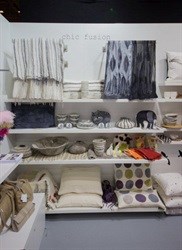At three international lifestyle shows in Germany, the US and France, the Western Cape craft producers have notched up export orders worth over R1.5 million this year. Exports were achieved with the support of the Cape Craft & Design Institute (CCDI), which coordinates and manages export marketing opportunities, sponsored by the dti.
The enterprises participated in Ambiente in Germany in February, the New York Gift Fair in August, and Maison et Objet in France in September. At Ambiente, five craft producers took orders worth over R1 million and quoted on additional orders worth nearly R915 000. In New York, nine enterprises' sales and pending orders totalled nearly R360 000. Maison et Object sales and pending orders for six participants are still being assessed, but should total at least R136 800.
"While we have been attending Ambiente for the past five years, this was the first time CCDI supported producers at the Paris and New York shows," said Ryan Rode, CCDI market support coordinator for exports.
"It takes a few years of repeat visits to build confidence in the market. European business, including the UK, has slowed down because of the recession but the US market for South African craft is buoyant and growing rapidly. There is a significant trend towards high quality, unique handmade items that are ethically-sourced, support communities, preserve culture, are sustainable and tell a story."
The CCDI was set up in 2001 to promote and grow the economic sustainability of the craft and design sector in the Western Cape. If more administrative support becomes available, it plans to take part annually in two additional major shows in the UK and Australia.
"The goal is to build a strong brand in five markets, while also taking part in national South African pavilions at shows in developing countries."
Before the 2013 shows, the CCDI developed several new systems and templates as part of its briefing and mentoring programme to prepare the participants. These included:
- Developing an electronic order book that can be customised with each enterprise's logo and contact details. With the input of a product code and quantity, the programme adds the product description, unit price and total order price. Orders can be entered much faster and emailed immediately.
- Development of a standard shipping template tested in the market place and offered to emerging exporters as part of CCDI export awareness and readiness training.
- Craft enterprises now ship goods individually - previously the CCDI consolidated all the exports for a show under its own name. This is building craft producers' knowledge and ensures that any hold-ups with a consignment do not compromise other participants.
Value for money is a key trend. "The world is a lot more competitive and South Africa's distance from international markets adds to costs. High input costs and freight are two significant variables hampering serious growth for many craft producers.
"The challenge is for craft and design enterprises to keep their authenticity and creative integrity, while being commercial and competitive. There may have to be compromises to get a piece you love into the market, for example incorporating an element of machine production into the handmade," he concludes.
For more information, go to www.ccdi.org.za.









































